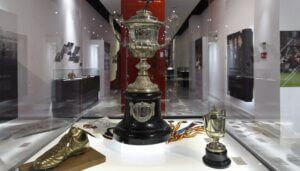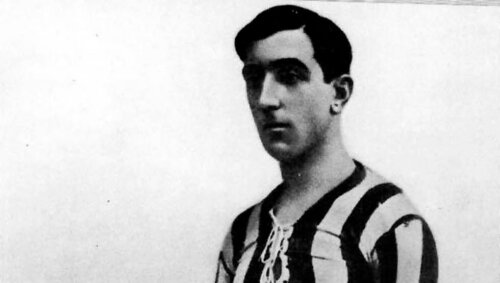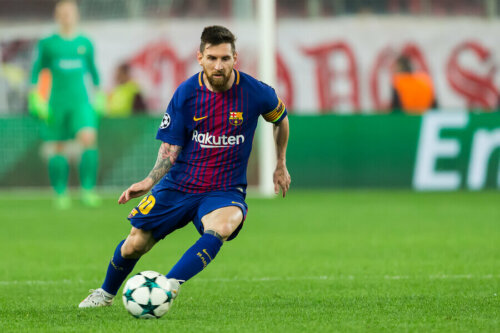The History of the Pichichi Trophy

Although it has a somewhat curious name, the Pichichi Trophy is very important in the Spanish League. Would you like to know the history of this trophy that the country’s top goalscorer receives every year? Below, we’ll tell you all about this very special trophy.
Why Pichichi?
Before talking about the Pichichi Trophy, we must talk about the man who it was named after. We’re referring to player Rafael Moreno Aranzadi, better known as “Pichichi”, who played as a forward for Athletic Bilbao.
Between 1910 and 1920, when the Spanish league hadn’t yet been created, Pichichi was a top goalscorer during several seasons. This included a hat-trick against RCD Español that led his team to victory.
Likewise, it’s worth noting that Moreno Aranzadi was the first to score a goal at the San Mamés Stadium, in 1913. In 1926, a bust was erected at this stadium, as a clear tribute to the player from Bilbao.

Pichichi died before his 30th birthday from an alleged shellfish poisoning after eating oysters. This occurred in 1922, a year after he retired from professional soccer.
Creation of the Pichichi Trophy
The trophy, which is unofficial and based on the chronicles of journalists, was created by the Spanish sports newspapers Marca and Arriba for the 1952-1953 season.
It’s a recognition for the top goalscorer of each season. The curious thing is that the players who scored the most goals since 1928 won it as well. Thanks to this retroactivity, the first winner of the Pichichi Trophy was Spanish player Paco Bienzobas. He was from Real Sociedad and scored 14 goals in 18 games in the 1928-29 season.
The winners of the Pichichi Trophy
However, the first winner “in due time and form” was Spaniard Telmo Zarra, of Athletic Bilbao. He scored 24 points in 29 games in the 1952-1953 season. In fact, Zarra had already won the trophy five times before.
Another player who’s won the Pichichi Trophy six times is Argentine player Lionel Messi. He won his first in the 2009-2010 season and his last in the 2019-2020 season.
In addition, Leo Messi is the player who’s scored the most goals in one season, as he scored 50 in 37 games in the 2011-2012 season. Also, he’s the player with the best ratio in a season. In 2012-2013, he scored 46 goals in 32 games, with a ratio of 1.44 per game.

Tied at five Pinichi Trophies each are the Argentine player Alfredo Di Stéfano (between 1953 and 1959), the Spanish player Enrique Castro (between 1973 and 1982), and the Mexican player Hugo Sánchez (between 1984 and 1990). Precisely this player from Atlético Madrid and Real Madrid boasts of having won the trophy four seasons in a row, a distinction he now shares with Lionel Messi.
Other recognized goalscorers
Among the other players who’ve won more than one Pichichi Trophy, we can highlight the Hungarian player Ferenc Puskás (four trophies between 1959 and 1964, playing for Real Madrid), the Spanish player Isidro Lángara (three trophies between 1933 and 1936, playing for Real Oviedo), the Spanish player José Eulogio Gárate (three trophies between 1968 and 1971, playing for Atlético Madrid), and the Portuguese player Cristiano Ronaldo (three trophies between 2010 and 2015, playing for Real Madrid).
Spaniards, Guillermo Gorostiza, Edmundo Suárez, Manuel Fernández, Amancio Amaro, and Raúl González, the Argentine player Mario Alberto Kempes, the Brazilian player Ronaldo, and the Uruguayan player Diego Forlán have won two trophies each.
Some years, two or three players that scored the same number of goals in one season also received it. For example, in the 1957-1958 season, Ricardo Alós, Manuel Badenes, and Alfredo Di Stefáno shared it, as they scored 19 goals each.
Similarly, in the 1969-1970 season, Amancio Amaro, Luis Aragonés, and José Eulogio Gárate (16 goals per player), in the 1968-1969 season, Amancio Amaro and José Gárate (14 goals each), and in the 1983-1984 season, Jorge da Silva and Juan Gómez (17 goals per player).
Although the Pichichi Trophy isn’t official, the European Golden Shoe, awarded by the European Sports Media, uses its statistics. The first to win the European Golden Shoe and the Pichichi Trophy the same year was Hugo Sánchez in the 1989-1990 season.
Finally, others who’ve achieved this were Ronaldo (1996-1997), Roy Makaay (2002-2003), Diego Forlán (2004-2005 and 2008-2009), Lionel Messi (six times 2009-2010, 2011-2012, 2012-2013, 2016-2017, 2017-2018, and 2018-2019), Cristiano Ronaldo (2010-2011, 2013-2014, and 2014-2015) and Luis Suárez (2015-2016).
Featured image: courtesy of sevillafc.com
Although it has a somewhat curious name, the Pichichi Trophy is very important in the Spanish League. Would you like to know the history of this trophy that the country’s top goalscorer receives every year? Below, we’ll tell you all about this very special trophy.
Why Pichichi?
Before talking about the Pichichi Trophy, we must talk about the man who it was named after. We’re referring to player Rafael Moreno Aranzadi, better known as “Pichichi”, who played as a forward for Athletic Bilbao.
Between 1910 and 1920, when the Spanish league hadn’t yet been created, Pichichi was a top goalscorer during several seasons. This included a hat-trick against RCD Español that led his team to victory.
Likewise, it’s worth noting that Moreno Aranzadi was the first to score a goal at the San Mamés Stadium, in 1913. In 1926, a bust was erected at this stadium, as a clear tribute to the player from Bilbao.

Pichichi died before his 30th birthday from an alleged shellfish poisoning after eating oysters. This occurred in 1922, a year after he retired from professional soccer.
Creation of the Pichichi Trophy
The trophy, which is unofficial and based on the chronicles of journalists, was created by the Spanish sports newspapers Marca and Arriba for the 1952-1953 season.
It’s a recognition for the top goalscorer of each season. The curious thing is that the players who scored the most goals since 1928 won it as well. Thanks to this retroactivity, the first winner of the Pichichi Trophy was Spanish player Paco Bienzobas. He was from Real Sociedad and scored 14 goals in 18 games in the 1928-29 season.
The winners of the Pichichi Trophy
However, the first winner “in due time and form” was Spaniard Telmo Zarra, of Athletic Bilbao. He scored 24 points in 29 games in the 1952-1953 season. In fact, Zarra had already won the trophy five times before.
Another player who’s won the Pichichi Trophy six times is Argentine player Lionel Messi. He won his first in the 2009-2010 season and his last in the 2019-2020 season.
In addition, Leo Messi is the player who’s scored the most goals in one season, as he scored 50 in 37 games in the 2011-2012 season. Also, he’s the player with the best ratio in a season. In 2012-2013, he scored 46 goals in 32 games, with a ratio of 1.44 per game.

Tied at five Pinichi Trophies each are the Argentine player Alfredo Di Stéfano (between 1953 and 1959), the Spanish player Enrique Castro (between 1973 and 1982), and the Mexican player Hugo Sánchez (between 1984 and 1990). Precisely this player from Atlético Madrid and Real Madrid boasts of having won the trophy four seasons in a row, a distinction he now shares with Lionel Messi.
Other recognized goalscorers
Among the other players who’ve won more than one Pichichi Trophy, we can highlight the Hungarian player Ferenc Puskás (four trophies between 1959 and 1964, playing for Real Madrid), the Spanish player Isidro Lángara (three trophies between 1933 and 1936, playing for Real Oviedo), the Spanish player José Eulogio Gárate (three trophies between 1968 and 1971, playing for Atlético Madrid), and the Portuguese player Cristiano Ronaldo (three trophies between 2010 and 2015, playing for Real Madrid).
Spaniards, Guillermo Gorostiza, Edmundo Suárez, Manuel Fernández, Amancio Amaro, and Raúl González, the Argentine player Mario Alberto Kempes, the Brazilian player Ronaldo, and the Uruguayan player Diego Forlán have won two trophies each.
Some years, two or three players that scored the same number of goals in one season also received it. For example, in the 1957-1958 season, Ricardo Alós, Manuel Badenes, and Alfredo Di Stefáno shared it, as they scored 19 goals each.
Similarly, in the 1969-1970 season, Amancio Amaro, Luis Aragonés, and José Eulogio Gárate (16 goals per player), in the 1968-1969 season, Amancio Amaro and José Gárate (14 goals each), and in the 1983-1984 season, Jorge da Silva and Juan Gómez (17 goals per player).
Although the Pichichi Trophy isn’t official, the European Golden Shoe, awarded by the European Sports Media, uses its statistics. The first to win the European Golden Shoe and the Pichichi Trophy the same year was Hugo Sánchez in the 1989-1990 season.
Finally, others who’ve achieved this were Ronaldo (1996-1997), Roy Makaay (2002-2003), Diego Forlán (2004-2005 and 2008-2009), Lionel Messi (six times 2009-2010, 2011-2012, 2012-2013, 2016-2017, 2017-2018, and 2018-2019), Cristiano Ronaldo (2010-2011, 2013-2014, and 2014-2015) and Luis Suárez (2015-2016).
Featured image: courtesy of sevillafc.com
All cited sources were thoroughly reviewed by our team to ensure their quality, reliability, currency, and validity. The bibliography of this article was considered reliable and of academic or scientific accuracy.
- Goal – ¿Por qué se llama ‘Pichichi’ al máximo goleador de La Liga de España? – Mayo 2020 – https://www.goal.com/es/noticias/por-que-se-llama-pichichi-al-maximo-goleador-de-la-liga-en/scjl5ru2mahc16s93vzwte6gz
- FC Barcelona – Superar a Zarra y a Pelé, los dos próximos retos históricos de Leo Messi – Junio 2020 – https://www.fcbarcelona.es/es/futbol/primer-equipo/noticias/1677178/superar-a-zarra-y-a-pele-los-dos-proximos-retos-historicos-de-leo-messi
This text is provided for informational purposes only and does not replace consultation with a professional. If in doubt, consult your specialist.








